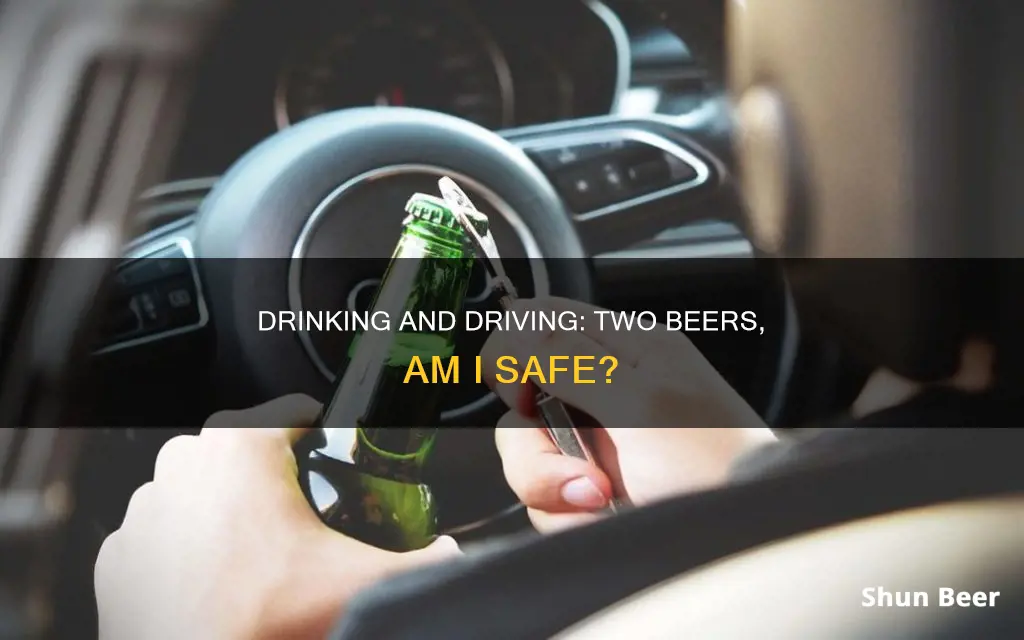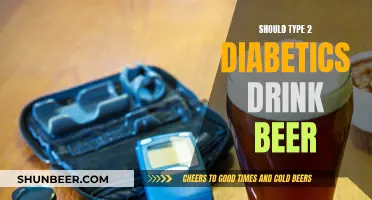
Drinking and driving is a dangerous combination, and it's important to understand the risks before getting behind the wheel after consuming alcohol. While the legal blood alcohol concentration (BAC) limit in most states is .08%
| Characteristics | Values |
|---|---|
| Number of beers | 2 |
| Recommended waiting time | 2 hours |
| Blood Alcohol Concentration (BAC) limit in the US | 0.08% |
| Factors influencing BAC | Weight, height, food intake, medication, drinking speed, biological sex, age |
| Effects of alcohol | Impaired judgement, slowed reaction time, reduced coordination, impaired ability to control the car or speed |
What You'll Learn

Factors influencing intoxication
There are many factors that influence intoxication. Here are some key considerations:
Amount and Speed of Consumption
The amount of alcohol consumed and the speed of consumption are significant factors. The more alcohol consumed in a short period, the higher the Blood Alcohol Content (BAC). Drinking at a slower pace gives the body more time to process the alcohol, leading to lower BAC levels.
Biological and Genetic Factors
An individual's biological and genetic makeup can influence their susceptibility to intoxication. For example, individuals with a family history of alcoholism may have an increased risk. Additionally, certain ethnic groups, such as those of Asian or Native American descent, tend to have reduced levels of alcohol dehydrogenase, leading to alcohol remaining in the bloodstream for longer.
Sex Differences
Men and women metabolize alcohol differently due to variations in enzyme production and body composition. Women generally have lower levels of alcohol dehydrogenase, resulting in alcohol remaining in their bloodstream longer. They also tend to have a higher percentage of body fat, which affects alcohol distribution in the body. These factors contribute to women achieving higher BAC levels than men when consuming the same amount of alcohol.
Body Size and Composition
Body size and composition play a role in intoxication. Smaller individuals with a lower body weight will generally become impaired more quickly. Alcohol distributes throughout the body, except in bone and fat tissue. As body fat increases, the concentration of alcohol in the lean tissues proportionally increases, leading to faster intoxication.
Food Consumption
Consuming food, especially high-protein meals, before or while drinking can significantly impact intoxication levels. Food in the stomach slows the absorption of alcohol into the bloodstream. Larger meals, closer to the time of drinking, can effectively lower the peak BAC. On the other hand, drinking on an empty stomach leads to faster absorption and higher BAC levels.
Carbonated Beverages
Carbonated beverages, such as mixed drinks or champagne, speed up alcohol absorption. The carbonation accelerates the absorption of alcohol into the bloodstream, leading to quicker intoxication.
Emotional and Psychological State
Strong emotions like anger, fear, or loneliness can hasten impairment. Additionally, expectations and psychological factors can influence the experience of intoxication. For example, individuals intending to get "drunk" may achieve higher levels of intoxication, even on non-alcoholic drinks.
Sleep and Fatigue
Lack of sleep or fatigue can intensify the effects of alcohol. Insufficient sleep reduces tolerance, leading to impairment at lower BAC levels. Similarly, fatigue causes symptoms similar to intoxication, and when combined with alcohol consumption, it can magnify the effects.
Drug and Medication Interactions
Mixing alcohol with certain drugs or medications can have hazardous consequences. For example, over-the-counter painkillers like aspirin, ibuprofen, or acetaminophen can create a "bottleneck" in the liver, leading to incorrect processing and harmful by-products. Always consult a healthcare provider for advice on alcohol intake when taking any medication.
Age
Age-related factors, such as slowed circulation and lower muscle mass, influence how alcohol is distributed, metabolized, and eliminated from the body.
Botox and Beer: What's Safe to Drink Post-Treatment?
You may want to see also

Blood Alcohol Concentration (BAC)
The amount of alcohol in your blood can vary based on several factors, including the amount of alcohol you consume, how quickly you're drinking, how much food you ate before drinking, your age, and your weight. For instance, a small shot of liquor takes around one hour for the body to metabolise, whereas a pint of beer takes two hours, and a large glass of wine takes three hours.
Different levels of BAC will result in different physical and mental effects. For example, a BAC of 0.02% may lead to an altered mood, relaxation, and a slight loss of judgment. At 0.05% BAC, you may experience uninhibited behaviour, lowered alertness, and impaired judgment. As BAC surpasses 0.055%, the drinker starts to experience the depressant effects of alcohol, such as fatigue, slurred speech, and lack of balance.
In most US states, a BAC of 0.08% is the legal limit for driving. However, it's important to note that driving skills can be impaired even if you're under the legal limit. The safest option is to refrain from driving after consuming any amount of alcohol.
Cemetery Drinking: Is Beer Allowed on Sacred Grounds?
You may want to see also

Personal breathalysers
While there are no specific sources addressing whether it is safe to drive after drinking two beers, it is important to note that drinking and driving do not mix. Alcohol impairs judgement, slows reaction time, and affects coordination and control, among other things. The safest thing to do is to refrain from driving after consuming alcohol.
To help make informed decisions about driving after drinking, some individuals may choose to use personal breathalysers. These devices provide an estimate of a person's intoxication level by measuring the concentration of alcohol in their breath. When considering purchasing a personal breathalyser, there are several factors to keep in mind:
- Type of breathalyser: There are two main types of breathalysers: those that use semiconductor sensors and those that use fuel cell sensors. Semiconductor breathalysers are less accurate and more susceptible to interference from other substances, while fuel cell breathalysers are more accurate and reliable.
- Accuracy: While no breathalyser can claim 100% accuracy due to variations in body types, look for devices with a controlled accuracy reading of +/-0.01% variance and a good accuracy of +/- 10% as per AS3547.
- Recalibration: Over time, breathalyser sensors become less accurate and need to be recalibrated. Choose a device that can be recalibrated by trained professionals to ensure ongoing accuracy.
- Standards and certification: Ensure that the breathalyser meets the required standards for your region and is certified for accuracy and durability, such as the Australian Standard AS3547.
- Maintenance: Breathalysers require regular maintenance and calibration to ensure optimal performance and accuracy. Follow the manufacturer's instructions and guidelines for storing and maintaining your device.
- Features: Consider the features that are important to you, such as memory storage, retractable mouthpiece, Bluetooth connectivity, mobile app compatibility, and indicator lights.
- AlcoSense Verity Personal Breathalyser: This device offers certified accuracy, a compact and lightweight design, simple one-button operation, memory storage for up to 10 test results, and a stylish and versatile look.
- BACtrack C8 Personal Breathalyser: This breathalyser features a compact and multifunctional design, making it easy to carry around.
- Proline BT-1 and BT-2 Drink Buddy Personal Breathalyser: These devices utilise advanced fuel cell technology and deliver accurate readings to 0.005% and 0.05% BAC.
- AlcoSense Elite 3 BT Personal Breathalyser: This breathalyser is designed for modern-day professionals, featuring Bluetooth connectivity and the ability to track alcohol test readings through a mobile app.
- Andatech Prodigy S Handheld Breathalyser: A professional-grade device with Bluetooth printer compatibility, built-in memory, and a fast response time.
Beer Distributors: The Logistics of Getting Beer to Customers
You may want to see also

Legal consequences of drunk driving
Drinking and driving is a serious issue that can have severe and long-lasting consequences. Driving under the influence (DUI) is the most common criminal offense in the United States, and it can turn your life upside down. Here are some of the legal consequences you may face if convicted of a DUI:
License Suspension or Revocation: One of the most immediate consequences of a DUI is the loss of your driving privileges. The length of suspension varies by state, with some states imposing a 30-day suspension for a first offense, while others may suspend your license for a year or more. For repeat offenses, some states will even revoke your driver's license permanently.
Fines and Fees: DUI convictions typically come with hefty fines and fees. In most states, a first-offense DUI will result in at least $500 in fines, and you may also have to pay additional fees for license reinstatement and court costs, which can amount to several hundred dollars.
Jail Time: Many states have mandatory jail time for DUI convictions, especially for second and subsequent offenses. For example, in Texas, a first-offense DUI carries a minimum of 72 hours in jail. The likelihood and duration of jail time often increase with each subsequent offense.
Ignition Interlock Devices (IIDs): Many states require individuals convicted of DUI to install IIDs in their vehicles. These devices are breathalyzers connected to the car's ignition system, preventing the car from starting if alcohol is detected on the driver's breath. The cost of installing and maintaining an IID is typically borne by the defendant.
Substance Abuse Treatment: Several states mandate that DUI offenders participate in substance abuse education or treatment programs. This may involve undergoing a substance abuse evaluation and completing any recommended treatment.
Increased Insurance Rates: A DUI conviction will significantly impact your auto insurance rates. Insurance companies consider drivers with a DUI conviction as "high-risk," and your insurance rates may double or triple for several years. Some insurance providers may even terminate your coverage.
Employment and Background Checks: A DUI conviction can also affect your current and future employment prospects. It may interfere with your current job due to court dates and community service requirements. When applying for new jobs, a DUI conviction may show up in background checks, causing potential employers to view your application negatively or disqualify you altogether.
Personal Relationships: A DUI arrest or conviction can strain your relationships with friends and family members. They may become overly concerned about your well-being and want to discuss your drinking habits, even if you feel it's under control.
Scholarship and Education Opportunities: DUI convictions can also impact your educational pursuits. Many colleges conduct background checks and require applicants to disclose any criminal history, which may result in denied admission or revoked scholarships.
The legal consequences of drunk driving are severe and far-reaching. The best way to avoid these consequences is to refrain from driving after consuming any amount of alcohol.
Beer and Kolonopin: A Safe Mix?
You may want to see also

Alternatives to drinking and driving
Drinking and driving is not only illegal but also extremely dangerous. Alcohol impairs your judgement, slows your reaction time, and makes it difficult to focus on driving, among other things. If you plan to drink, it's always best to make alternative arrangements for getting home. Here are some safe alternatives to drinking and driving:
Ridesharing Services
Ridesharing services like Uber and Lyft have become a staple of urban mobility. They offer a quick, efficient, and convenient way to book a ride using their apps. These services are available in most urban and suburban areas, providing a reliable form of transport, especially for those who may be impaired after drinking.
Taxis
Taxis have been a traditional and reliable mode of transportation for a long time. They are widely available, especially in cities, and can often be hailed on the street. Taxi drivers usually have extensive knowledge of the local area, which can be beneficial when navigating heavy traffic or finding the quickest routes.
Public Transportation
Public transportation systems, including buses, trains, subways, and trams, offer a network of travel options. They are cost-effective and environmentally friendly, reducing traffic congestion and emissions. In urban areas, public transit often runs late into the night, providing a reliable option for those enjoying the city's nightlife.
Designated Driver
Appointing a designated driver within your group is a safe and economical option. This person abstains from drinking for the night and remains sober to drive everyone home safely. It's important to choose someone who can resist the temptation to consume alcohol and to make a clear plan before anyone starts drinking.
Local Community Programs
Safe Rides programs are often run by volunteer or non-profit organizations, providing free or low-cost transportation for individuals who are too impaired to drive. These initiatives vary by community and may include services that tow your vehicle to your home along with providing you a safe ride.
Stay at a Friend's Place or Nearby Hotel
Planning to stay at a friend's place or booking a nearby hotel can be a safe alternative to driving after drinking. This option requires good communication and preparation, ensuring you have everything you need for the night.
Remember, the key to the success of these alternatives is having a plan. By choosing one of these options, you can help keep yourself, your loved ones, and others on the road safe.
Does Your Growler Still Offer Fresh Beer?
You may want to see also
Frequently asked questions
No, you should never drink and drive, even if you've only had one alcoholic beverage. If you are charged with drunk driving in any state, you may face steep fines and jail time.
According to the National Institute on Alcohol, you should wait at least one hour per drink. However, this is not a sure-fire way to keep your BAC down, as other factors may affect your blood alcohol level.
Your weight, gender, age, medication, how quickly you drink, and whether you have eaten recently all play a role in determining your blood alcohol level.







